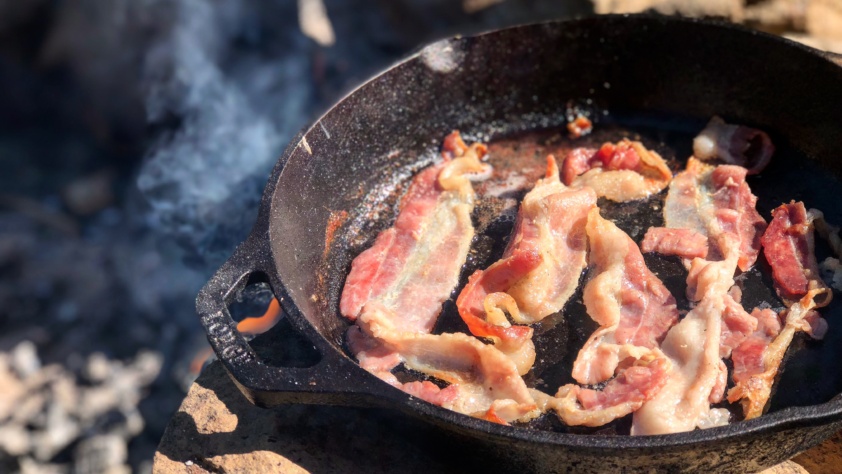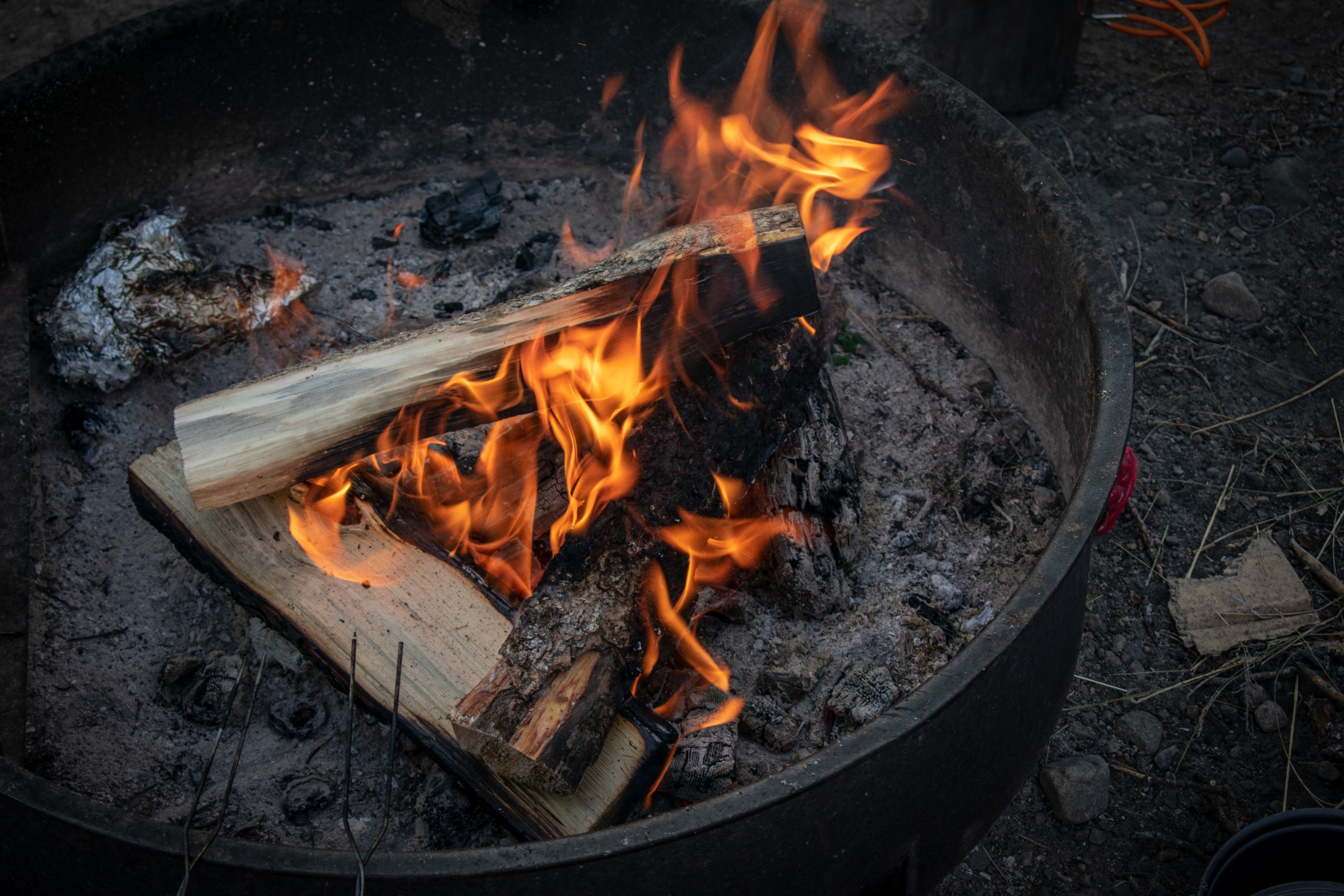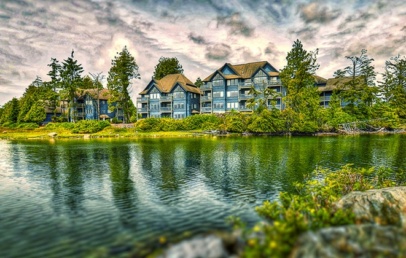Once you’ve got your camping spot lined up you can focus on the best thing about camping: cooking over a fire. A little prep can turn a caveman chore into a glamping feast.
Accessories – No matter what you call it, a metal flipper, grill turner, or spatula is essential for grilling meats and flipping morning pancakes. Long metal tongs and a fire-safe mitt are also useful tools for campfire cooking. Metal sticks for cooking wieners over the fire are a great alternative to wood sticks if you’re camping in a regulated camp site and cutting into trees is frowned upon. A knife and chopping board will be necessary for food prep. Other essential items include a scrub brush, dish cloth and towel, tin foil, and for food safety, a meat thermometer.
Breakfast – There’s nothing like drinking a hot coffee on a cool morning around a campfire. Cocoa or tea are also nice breakfast drinks while you’re making breakfast. Bacon and eggs. Hashbrown potatoes and sausages. Pancakes and syrup. French toast with fruit. Hearty oats with brown sugar and milk. Breakfast time is the best time!
Cookware – Cast iron works great on a fire, from frying pans to griddles to dutch ovens. If you’re looking to keep things light, you may want to look into aluminum pots and frying pans. Don’t forget to bring a campfire percolator for your morning coffee!
Dishes – Reusable metal or plastic dishes are a greener choice than paper plates and plastic cups but disposable dishes can have advantages too, as long as you’re packing out to recycle what you packed in. Same goes with cutlery. Bring a dishpan and eco-friendly dish soap for washing up after meals.
Embers – A roaring fire is actually not ideal for cooking. To get a more consistent heat, let the fire burn down to the white hot coals. The temperature can still fluctuate, so make sure to turn your food often to prevent burning.

Fuel – If you’re planning on a campfire, check with the campsite on wood availability. Bringing your own? Make sure you pack enough for meals and evenings, and remember the kindling and a fire starter! A wood-burning campfire is ideal but it may not be permitted at certain times and locations. If you can’t light a fire, there are alternative choices such as small propane grills and camp stoves, and charcoal barbecues. Check with your local fire department for bylaws and restrictions.
Grate – Most campsite fire pits will have a grate for grilling and placing your cookware. If it doesn’t, or if you’re cooking off-grid, you can bring your own folding grate to place over the fire.
Heat – How high is the heat? To test the temperature of your campfire, hold your hand over the cooking area. If you can hold it for less than 1 second, the temperature is around 600° F (high). 1 – 2 seconds, 400 – 500° F (medium-high). 3 – 4 seconds, 350 – 375° F (medium). 5 – 7 seconds, 325 – 350° F (low).
Insects – If you’re getting bugged by mosquitoes around the campfire, throw some fresh lavender, rosemary, and sage on the fire. The smoke should keep the little biters at bay.
Jokes – I told my llama we were going camping. He yelled, “Alpaca tent!” If you didn’t get that, you’re too in-tents.
Knowledge – Brush up on your campfire know-how before you set out. Learning how to build a good campfire can improve your chances of having a great outdoor meal. Too many flames and you’ll burn your food. Building a circular cone-shaped fire is good for getting flames going and boiling water but burns through your wood more quickly. If you want a longer lasting fire, try the log cabin arrangement where the wood is stacked in alternating layers of two.
Lunch – Hamburgers and hotdogs are great meal ideas. Serve with corn on the cob, baked beans or mac and cheese. If meat on a bun is not fanning your flames, try a stir fry, chili or a soup or there are endless combinations of food you can cook in foil packets.
Meat – Although nothing says campfire like a burnt weiner on a stick, you can add to your repertoire with easy-to-cook steaks or salmon for dinner. Serve crispy bacon or sausages for breakfast. Not a meat fan? There are meat alternatives such as veggie burgers and portobello mushrooms that cook up great in a frying pan over the fire.

Necessities – A good campfire needs fuel, heat, and air. Wood for fuel, tinder and kindling for heat, and good air flow that is not too windy. Once you have your fire down to some hot coals, you are ready for cooking!
Oil – A good cooking oil lightly brushed on food before grilling will help keep it from sticking, and you may want to re-oil your cast iron pans after cleaning.
Pits and Rings – Most campgrounds will have a fire pit or ring, but if you are camping elsewhere, dig a fire pit with your handy-dandy shovel, circle it with rocks, and make sure that a ten-foot area around it is clear of anything that could catch fire.
Seasonings – Salt and pepper are cooking staples and you can make things even better with some additional flavors, such as garlic and onion powder, some dried dill, and rosemary.
Treats – Toasted marshmallows are the ubiquitous campfire dessert of them all and can be elevated by making them into s’mores with graham crackers and chocolate. You can make other treats in foil packets such as campfire dessert cones or popcorn. One fun treat to make is bannock, topped with butter and jam.
Use Care – Watch young children when roasting wieners or marshmallows. Never leave a fire unattended. Pans and griddles are very hot. Use a fire safe glove when removing from the fire. Keep pets away from the campfire. Tails and noses can get burnt!
Vegetables – Some veggies are easier prepped at home and packed in the cooler, such as salads, onions, and peppers. Potatoes are best cut up before cooking. Cook vegetables in a frying pan or in tin foil packets and corn on the cob can be cooked right in the husk.
Water – Ensure you have a good supply of water, not only for drinking and washing, but for dousing any embers that may escape your fire-safe perimeter. Remember that fire and oil are not friends and don’t throw water on a grease fire. Use sand or dirt instead.
Yummy – There is nothing like food cooked over an open fire. The feeling of primitive pride when you bite into your perfectly cooked hotdog. When your marshmallow is golden brown, or sufficiently burnt if that’s to your taste. Eating around the fire adds to the overall ambience of your meal. Is there anything better?
Zero trace – Like with any camping, plan to leave no trace behind, save for a few ashes in the fire pit that has been properly extinguished with a shovel and some water. If it’s too hot to touch, it’s too hot to leave.




